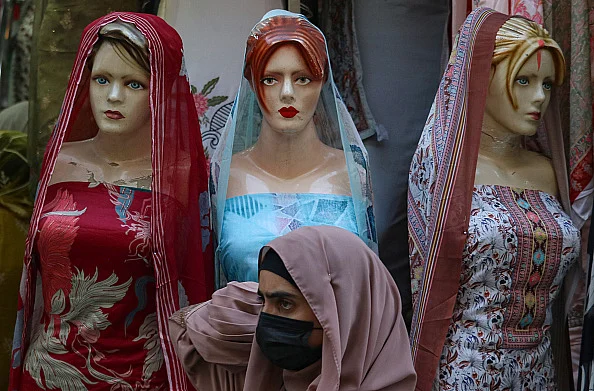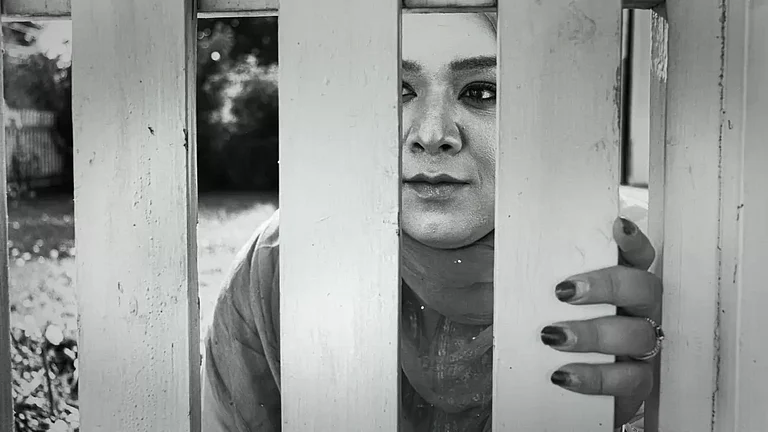It could have been a photo people posted on family WhatsApp groups on what seemed like a routine day—a young girl in a crowded metro, clicked by a friend.
The difference, however, was that it was not a friendly click. The photo was maliciously made public on social media. An anonymous social media handle posted the picture, “calling the girl out” for “having an affair with a Hindu boy”. The post’s caption said: “The girl in hijab was in a relationship with a Hindu boy”, who had “gotten off the metro at a station” before the picture was supposedly taken.
What followed was a barrage of comments against the girl in particular and women from Kashmir working or studying outside the Valley in general. Religion was invoked, the girl was vilified.
This is one brazen example of social media defamation of girls in Kashmir—a Muslim-majority region not known to enforce diktats on either dress or morality, except for a brief period in the 1990s when an all-women separatist organisation, Dhuktaran-e-Milat, tried to enforce hijab. The movement did not last, as it failed to garner public support. The Dhuktaran cadre, known for throwing colour on “non-hijabi women”, was denounced for humiliating girls publicly.
However, for some time now, fast-sprouting faceless accounts/handles have been using social media as a platform for the resurgence of this very narrative. For them, everything spells problems—girls enjoying a musical evening at a college fest, marriages, relationships and even friendships happening outside of religion and region.
In a similar incident a few months ago, a Kashmiri girl and her friends, who happened to be her non-local classmates, were attacked by a mob of local boys. Later, the video of the altercation was uploaded on social media. The video identified the girl, her residence, and the educational institute. The video was, however, taken down, sources say, following intervention by the local police.
Not Standalone Incidents
These incidents are not standalone. For years, the social media landscape in Kashmir is reeking of misogyny. The real-life misogyny is spilling onto social media platforms.
Taking a leaf from the right-wing book, Kashmiri men, like the Hindutva brigade in the rest of the country, want to take control of “what women do” and “what they wear”. Some call it the rise of the “right in Kashmir”, others a “mere reaction” to what is happening in the rest of the country in the name of “love jihad”. Technology and social media are providing the required tools to spread this misogyny.
Girls are trolled for anything from riding a bike to reciting poetry. “Papa ki pari” is a highly abused tagline, used not only in Kashmir but the rest of the country as well.
Social Scientists agree that cyber misogyny is on the rise.
“Social media is a new platform that has given people the agency and space to express themselves. The abuse that women face in private and public spaces is now being witnessed on virtual platforms as well. Women face ‘digital abuse’ for numerous reasons, and misogyny is the most important one,” said sociologist Farah Qayoom.
The trend started with trolling women for their choice of clothes and careers, demeaning their achievements and has now become a new form of harassment for Kashmiri women on social media.
Any out-of-the-box video featuring a girl, any achievement highlighted on social media has some keyboard warrior sitting on a prowl.
In February 2022, Srinagar’s Aroosa Parvaiz, who had topped class 12 board exams in the science stream, was trolled for not wearing a hijab after photographs of her without a headscarf went viral across social media.
The 17-year-old girl, who was hailed as an achiever by people, was soon targeted for her appearance with derogatory comments and vicious attacks flooding social media. Some people hide behind the anonymity of unidentified accounts and use hate and trolling as weapons of harassment and character assassination.
The incident happened in the backdrop of Karnataka’s hijab ban in educational institutes.
More recently, in October, a video from a college festival in SKUAST, Jammu, was relentlessly shared on X with sermons of “dwindling morals of Kashmir students, especially girls”. The X user called the video “a serious concern” because young female students were seen clapping and enjoying the musical programme. Questions were raised about Kashmiri values and the dwindling morality. In another post, the same user posted a video of a male singer singing in woods and called it “mesmerising”.
Shrinking Social Media Space
Experts agree social media spaces are shrinking for women in Kashmir, and most women are leaving platforms for fear of being trolled. “On social media platforms, many Kashmiri women are targeted for their dress, not covering their head, their appearance, and so on. Often, it is seen that the ones doing it use religion to malign women. Misogynist religious ideology is reflected when many Kashmiri women are asked to keep their heads covered, to wear a certain type of dress, and are accused of having relations with Hindu boys,” Qayoom adds.
However, she adds that the digital abuse that women face is not confined to Kashmir but is the same as it is in the rest of the country. “It’s a reflection of the larger social inequality that women are inferior to men that prevails in our society,” she says.
Statistics show women across the world are subjected to abuse. A 2023 UN report says 16-58 per cent of women are targeted online in Kashmir; however, it is being used as a tool for the subjugation of females.
Creating Synthetic Role Models
Another phenomenon Kashmir watchers believe that fuels the misogyny is the “synthetic role model narrative”.
“A certain set of women, who are pro-administration, mostly seen supporting the BJP at the Centre government and its stance on Kashmir, are being promoted as role models for Kashmiri women and girls,” says a politician who did not want to be named. “The state facilitates these women; they call themselves social media influencers but are government mouthpieces. This type of social remodelling and botched reengineering has also made people sceptical of the rise of girls as social media opinion-makers or role models. And as a consequence, common women and girls are unfortunately bearing the brunt,” he adds.
This “role model” trend started in 2019, when a girl claiming to be Kashmiri featured in viral videos extending support for abrogation of Article 370. A media article later revealed the girl was not “a Kashmiri Muslim” as was being projected but a Sindhi who claimed ancestry in Kashmir.
The young girl, who later married a Kashmiri politician from BJP, has since spoken in various international forums supporting India’s reading down of the special status of Jammu and Kashmir.
Experts say such achievers and influencers undermine the real achievers and leave people with a sense of doubt. “State manufacturing role models, stigmatises the narratives and helps further fuel misogyny,” says an expert.
Surprising as it may sound, in a place like Kashmir, where any social media post can lead to years in jail, the trend is catching on unabated.
Police say they initiate action upon receiving complaints. Whether the complaint is from the victim or flagged by another person, the concerns are met with “swift and decisive action”. However, Inspector General of Police, Kashmir, V K Birdi, urged “women to report the incidents”.
“We acknowledge the problem, are cautious, and try to scan social media for such incidents. But people have to also come forward. If any girl feels threatened, she can register a complaint at our cyber police station, and we will take the required action. We have acted very swiftly many times when women have complained,” he says. “However, if the content is viral and risks the safety of the women/girls, action is taken without any complaints,” he adds.
Is cyber harassment of women a reaction to the “love Jihad” conspiracy theory in the rest of the country?
“They have anti-conversion laws, and we can’t even talk about it”, “are you supporting organised bhagwa ‘love traps’, “are you also sleeping with some Hindu?”, and many similar replies with extremely unparliamentary language were reactions this reporter got after objecting to a misogynist post regarding interfaith relationships.
Most of the abusive replies were from accounts formed a few months ago with just a few followers.
Although cyber trolling is a common phenomenon, social scientists say the trolls are taking refuge in the “love jihad conspiracy” being fuelled in the rest of the country. Every time an Islamophobic incident takes place in the rest of the country, misogynistic and trolling incidents of women are on the rise.
Earlier this year, many X accounts, including that of a senior politician, ran into trouble with law enforcement agencies when the marriage certificate of a local Kashmiri Muslim girl with a Hindu non-Kashmiri boy was widely circulated on social media. Another document confirming her religious conversion also went viral.
The incident had many Kashmiris crying foul claiming such marriages and conversions were part of “organised bhagwa love traps”. Many users on X claimed the Centre and state were closing their eyes to the cases where the brides happened to be Muslim, especially Kashmiri.
Junaid Azim Mattu, former mayor of Srinagar, posted the same documents on his X account, trying to draw a parallel with a case of a cleric of Dargah Hazratbal, who was barred from performing religious duties for “helping a man convert to Islam”.
“A 23-year-old Muslim girl, Humerah, from a village in Baramulla is converted to Hinduism by Sanatan Vedic Samaj Kalyan Sansthan, given a name Purni, and married to a certain Mr. Parihar from Maharashtra by an organisation that proclaims, “approved by the government of India. No cry for Love Dharam Yudh?” Mattu had written.
Existence of Traditional Misogyny
While Kashmir has not been a strictly patriarchal society but it’s also not a matriarchal society as well. Although women have traditionally been given opportunities in education and employment, men have greater power and social status than women.
Qayoom said that the problem is that “in a traditional society like Kashmir, children are not socialised to accept gender equality”. “We don’t inculcate a gender-sensitive approach in our children. Boys are made to believe that they are superior, and girls are inferior. When such boys grow up, they harbour a misogynistic attitude, and it is reflected in their expressions over social media and other such platforms,” Qayoom says.
Qayoom believes there is a need for comprehensive strategies to address this pressing issue; people must learn to create a balance between traditional and cultural beliefs and modern life.
Social scientists say society has to be reminded that respect for women cannot be only for those, those who live in your home, your mother and daughters but it has to be extended to those whom you don't know. Those whom you meet in unfamiliar situations like social media. “These interactions would define who you are,” says Qayoom.
These interactions cannot be governed by premature judgements, the patriarchal norms and predetermined or predefined rules particularly for women.





















